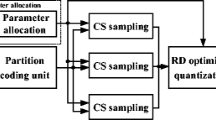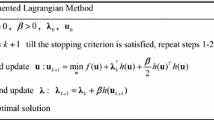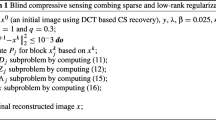Abstract
Closed-loop architecture is widely utilized in automatic control systems and attains distinguished dynamic and static performance. However, classical compressive sensing systems employ an open-loop architecture with separated sampling and reconstruction units. Therefore, a method of iterative compensation recovery for image compressive sensing is proposed by introducing a closed-loop framework into traditional compressive sensing systems. The proposed method depends on any existing approaches and upgrades their reconstruction performance by adding a negative feedback structure. Theoretical analysis of the negative feedback of compressive sensing systems is performed. An approximate mathematical proof of the effectiveness of the proposed method is also provided. Simulation experiments on more than 3 image datasets show that the proposed method is superior to 10 competing approaches in reconstruction performance. The maximum increment of the average peak signal-to-noise ratio is 4.36 dB, and the maximum increment of the average structural similarity is 0.034 based on one dataset. The proposed method based on a negative feedback mechanism can efficiently correct the recovery error in the existing image compressive sensing systems.














Similar content being viewed by others
Data availability
Not applicable.
References
Yang, Y., Sun, J., Li, H.B., Xu, Z.B.: DMM-CSNet: a deep learning approach for image compressive sensing. IEEE Trans. Pattern Anal. Mach. Intell. 42(3), 521–538 (2020). https://doi.org/10.1109/TPAMI.2018.2883941
Shi, W.Z., Jiang, F., Liu, S.H., Teramoto, A., Zhao, D.B.: Image compressed sensing using convolutional neural network. IEEE Trans. Image Process. 29, 375–388 (2020). https://doi.org/10.1109/TIP.2019.2928136
Tavares, C.A., Santos, T.M.R., Lemes, N.H.T., dos Santos, J.P.C., Ferreira, J.C., Braga, J.P.: Solving ill-posed problems faster using fractional-order Hopfield neural network. J. Comput. Appl. Math. 381, 1–14 (2021). https://doi.org/10.1016/j.cam.2020.112984
Zhang, Y., Hofmann, B.: On the second-order asymptotical regularization of linear ill-posed inverse problems. Appl. Anal. 99(6), 1000–1025 (2020). https://doi.org/10.1080/00036811.2018.1517412
Adler, J., Oktem, O.: Solving ill-posed inverse problems using iterative deep neural networks. Inverse Probl. 33(12), 1–10 (2017). https://doi.org/10.1088/1361-6420/aa9581
Huang, W.K., Zhou, F.B., Zou, T., Lu, P.W., Xue, Y.H., Liang, J.J., Dong, Y.K.: Alternating positive and negative feedback control model based on catastrophe theories. Mathematics 9(22), 1–19 (2021). https://doi.org/10.3390/math9222878
Li, L.X., Fang, Y., Liu, L.W., Peng, H.P., Kurths, J., Yang, Y.X.: Overview of compressed sensing: sensing model, reconstruction algorithm, and its applications. Appl. Sci. Basel 10(17), 1–19 (2020). https://doi.org/10.3390/app10175909
Monika, R., Samiappan, D., Kumar, R.: Adaptive block compressed sensing—a technological analysis and survey on challenges, innovation directions and applications. Multimed. Tools Appl. 80(3), 4751–5476 (2021). https://doi.org/10.1007/s11042-020-09932-0
Chen, Q.P., Shah, N.J., Worthoff, W.A.: Compressed sensing in sodium magnetic resonance imaging: techniques, applications, and future prospects. J. Mag. Reson. Imaging 55(5), 1340–1356 (2022). https://doi.org/10.1002/jmri.28029
Bustin, A., Fuin, N., Botnar, R.M., Prieto, C.: From compressed-sensing to artificial intelligence-based cardiac MRI reconstruction. Front. Cardiovasc. Med. 7, 1–19 (2020). https://doi.org/10.3389/fcvm.2020.00017
Chul, Y.J.: Compressed sensing MRI: a review from signal processing perspective. BMC Biomed. Eng. 1(8), 1–17 (2019). https://doi.org/10.1186/s42490-019-0006-z
Yang, J.G., Jin, T., Xiao, C., Huang, X.T.: Compressed sensing radar imaging: fundamentals, challenges, and advances. Sensors 19(14), 1–19 (2019). https://doi.org/10.3390/s19143100
Cao, B.H., Li, S.Z., Enze, C., Fan, M.B., Gan, F.X.: Progress in terahertz imaging technology. Spectrosc. Spect. Anal. 40(9), 2686–2695 (2020). https://doi.org/10.3964/j.issn.1000-0593(2020)09-2686-10
Ke, J., Zhang, L.X., Zhou, Q.: Applications of compressive sensing in optical imaging. Acta Optica Sinica 40(1), 1–10 (2020). https://doi.org/10.3788/AOS202040.0111006
Hirsch, L., Gonzalez, M.G., Vega, L.R.: A comparative study of time domain compressed sensing techniques for optoacoustic imaging. IEEE Latin Am. Trans. 20(6), 1018–1024 (2022). https://doi.org/10.1109/TLA.2022.9757745
Wang, J., Tong, Z.S., Hu, C.Y., Xu, M.C., Huang, Z.F.: Some mathematical problems in ghost imaging. Acta Optica Sinica 40(1), 1–10 (2020). https://doi.org/10.3788/AOS202040.0111007
Yousufi, M., Amir, M., Javed, U., Tayyib, M., Abdullah, S., Ullah, H., Qureshi, I.M., Alimgeer, K.S., Akram, M.W., Khan, K.B.: Application of compressive sensing to ultrasound images: a review. Biomed. Res. Int. 2019, 1–15 (2019). https://doi.org/10.1155/2019/7861651
Xie, Y.R., Castro, D.C., Rubakhin, S.S., Sweedler, J.V., Lam, F.: Enhancing the throughput of FT mass spectrometry imaging using joint compressed sensing and subspace modeling. Anal. Chem. 94(13), 5335–5343 (2022). https://doi.org/10.1021/acs.analchem.1c05279
Oiknine, Y., August, I., Farber, V., Gedalin, D., Stern, A.: Compressive sensing hyperspectral imaging by spectral multiplexing with liquid crystal. J. Imaging 5(1), 1–17 (2019). https://doi.org/10.3390/jimaging5010003
Calisesi, G., Ghezzi, A., Ancora, D., D’Andrea, C., Valentini, G., Farina, A., Bassi, A.: Compressed sensing in fluorescence microscopy. Prog. Biophys. Mol. Biol. 168, 66–80 (2022). https://doi.org/10.1016/j.pbiomolbio.2021.06.004
Monika, R., Dhanalakshmi, S., Kumar, R., Narayanamoorthi, R., Lai, K.W.: An efficient adaptive compressive sensing technique for underwater image compression in IoUT. Wirel. Netw. Early Access (2022). https://doi.org/10.1007/s11276-022-02921-1
Edgar, M.P., Gibson, G.M., Padgett, M.J.: Principles and prospects for single-pixel imaging. Nat. Photon. 13(1), 13–20 (2019). https://doi.org/10.1038/s41566-018-0300-7
Xiao, X.Y., Chen, L.Y., Zhang, X.Z., Wang, C., Lan, R.J., Ren, C., Cao, D.Z.: Review on single-pixel imaging and its probability statistical analysis. Laser Optoelectron. Progress 58(10), 1–10 (2021). https://doi.org/10.3788/L0P202158.1011018
Gibson, G.M., Johnson, S.D., Padgett, M.J.: Single-pixel imaging 12 years on: a review. Opt. Express 28(19), 28190–28208 (2020). https://doi.org/10.1364/OE.403195
Zanotto, L., Piccoli, R., Dong, J.L., Morandotti, R., Razzari, L.: Single-pixel terahertz imaging: a review. Opto Electron. Adv. 3(9), 1–15 (2020). https://doi.org/10.29026/oea.2020.200012
Liu, F., Yao, X.R., Liu, X.F., Zhai, G.J.: Single-photon time-resolved imaging spectroscopy based on compressed sensing. Laser Optoelectron. Progress 58(10), 1–10 (2021). https://doi.org/10.3788/LOP202158.1011016
Zhang, M.L.: Compressive sensing acquisition with application to Marchenko imaging. Pure Appl. Geophys. Early Access (2022). https://doi.org/10.1007/s00024-022-03029-5
Ravishankar, S., Ye, J.C., Fessler, J.A.: Image reconstruction: from sparsity to data-adaptive methods and machine learning. Proc. IEEE 108(1), 86–109 (2020). https://doi.org/10.1109/JPROC.2019.2936204
Xie, Y.T., Li, Q.Z.: A review of deep learning methods for compressed sensing image reconstruction and its medical applications. Electronics 11(4), 586 (2022). https://doi.org/10.3390/electronics11040586
Saideni, W., Helbert, D., Courreges, F., Cances, J.P.: An overview on deep learning techniques for video compressive sensing. Appl. Sci. BASEL 12(5), 2734 (2022). https://doi.org/10.3390/app12052734
Khosravy, M., Cabral, T.W., Luiz, M.M., Gupta, N., Crespo, R.G.: Random acquisition in compressive sensing: a comprehensive overview. Int. J. Amb. Comput. Intell. 12(3), 140–165 (2021). https://doi.org/10.4018/IJACI.2021070107
Mishra, I., Jain, S.: Soft computing based compressive sensing techniques in signal processing: a comprehensive review. J. Intell. Syst. 30(1), 312–326 (2021). https://doi.org/10.1515/jisys-2019-0215
Chen, Y.T., Schonlieb, C.B., Lio, P., Leiner, T., Dragotti, P.L., Wang, G., Rueckert, D., Firmin, D., Yang, G.: AI-based reconstruction for fast MRI-a systematic review and meta-analysis. Proc. IEEE 110(2), 224–245 (2022). https://doi.org/10.1109/JPROC.2022.3141367
Zhang, M.L., Zhang, M.Y., Zhang, F., Chaddad, A., Evans, A.: Robust brain MR image compressive sensing via re-weighted total variation and sparse regression. Magn. Reson. Imaging 85, 271–286 (2022). https://doi.org/10.1016/j.mri.2021.10.031
Zhang, J.C., Han, L.L., Sun, J.Z., Wang, Z.K., Xu, W.L., Chu, Y.H., Xia, L., Jiang, M.F.: Compressed sensing based dynamic MR image reconstruction by using 3D-total generalized variation and tensor decomposition: k-t TGV-TD. BMC Med. Imaging 22(1), 1–10 (2022). https://doi.org/10.1186/s12880-022-00826-1
Yin, Z., Shi, W.Z., Wu, Z.C., Zhang, J.: Multilevel wavelet-based hierarchical networks for image compressed sensing. Pattern Recogn. 129, 1–12 (2022). https://doi.org/10.1016/j.patcog.2022.108758
Yin, Z., Wu, Z.C., Zhang, J.: A deep network based on wavelet transform for image compressed sensing. Circuits Syst. Signal Process. Early Access (2022). https://doi.org/10.1007/s00034-022-02058-8
Lv, M.J., Ma, L., Ma, J.C., Chen, W.F., Yang, J., Ma, X.Y., Cheng, Q.: Fast, super-resolution sparse inverse synthetic aperture radar imaging via continuous compressive sensing. IET Signal Proc. 16(3), 310–326 (2022). https://doi.org/10.1049/sil2.12092
Sun, M., Tao, J.X., Ye, Z.F., Qiu, B.S., Xu, J.Z., Xi, C.F.: An algorithm combining analysis-based blind compressed sensing and nonlocal low-rank constraints for MRI reconstruction. Curr. Med. Imaging Rev. 15(3), 281–291 (2019). https://doi.org/10.2174/1573405614666180130151333
Li, H.G.: Compressive domain spatial-temporal difference saliency-based realtime adaptive measurement method for video recovery. IET Image Proc. 13(11), 2008–2017 (2019). https://doi.org/10.1049/iet-ipr.2019.0116
Suantai, S., Noor, M.A., Kankam, K., Cholamjiak, P.: Novel forward–backward algorithms for optimization and applications to compressive sensing and image inpainting. Adv. Differ. Equ. 2021(1), 1–22 (2021). https://doi.org/10.1186/s13662-021-03422-9
Mardani, M., Gong, E.H., Cheng, J.Y., Vasanawala, S.S., Zaharchuk, G., Xing, L., Pauly, J.M.: Deep generative adversarial neural networks for compressive sensing MRI. IEEE Trans. Med. Imaging 38(1), 167–179 (2019). https://doi.org/10.1109/TMI.2018.2858752
Li, W.Z., Zhu, A.H., Xu, Y.G., Yin, H.S., Hua, G.: A fast multi-scale generative adversarial network for image compressed sensing. Entropy 24(6), 1–16 (2022). https://doi.org/10.3390/e24060775
Zeng, G.S., Guo, Y., Zhan, J.Y., Wang, Z., Lai, Z.Y., Du, X.F., Qu, X.B., Guo, D.: A review on deep learning MRI reconstruction without fully sampled k-space. BMC Med. Imaging 21(1), 1–11 (2021). https://doi.org/10.1186/s12880-021-00727-9
Han, Y., Sunwoo, L., Ye, J.C.: k-space deep learning for accelerated MRI. IEEE Trans. Med. Imaging 39(2), 377–386 (2020). https://doi.org/10.1109/TMI.2019.2927101
Kravets, V., Stern, A.: Progressive compressive sensing of large images with multiscale deep learning reconstruction. Sci. Rep. 12(1), 1–10 (2022). https://doi.org/10.1038/s41598-022-11401-7
Wang, Z.B., Qin, Y.L., Zheng, H., Wang, R.F.: Multiscale deep network for compressive sensing image reconstruction. J. EIectron. Imaging 31(1), 1–10 (2022). https://doi.org/10.1117/1.JEI.31.1.013025
Gan, H.P., Gao, Y., Liu, C.Y., Chen, H.W., Zhang, T., Liu, F.: AutoBCS: block-based image compressive sensing with data-driven acquisition and noniterative reconstruction. IEEE Trans. Cybern. Early Access (2021). https://doi.org/10.1109/TCYB.2021.3127657
You, D., Zhang, J., Xie, J.F., Chen, B., Ma, S.W.: COAST: controllable arbitrary-sampling network for compressive sensing. IEEE Trans. Image Process. 30, 6066–6080 (2021). https://doi.org/10.1109/TIP.2021.3091834
Song, J.C., Chen, B., Zhang, J.: Memory-augmented deep unfolding network for compressive sensing. In: Proceedings of ACM MM, Chengdu, Sichuan, China, pp. 1–10 (2021)
Zhang, J., Ghanem, B.: ISTA-Net: interpretable optimization-inspired deep network for image compressive sensing. In: Proceedings of CVPR, Salt Lake City, UT, USA, pp.1828–1837 (2018)
You, D., Xie, J.F., Zhang, J.: ISTA-Net++: flexible deep unfolding network for compressive sensing. In: Proceedings of ICME, Virtual, pp. 1–6 (2021)
Zhang, J., Zhao, C., Gao, W.: Optimization-inspired compact deep compressive sensing. IEEE J. Select. Top. Signal Process. 14(4), 765–774 (2020). https://doi.org/10.1109/JSTSP.2020.2977507
Zhang, J., Zhang, Z.Y., Xie, J.F., Zhang, Y.B.: High-throughput deep unfolding network for compressive sensing MRI. IEEE J. Select. Top. Signal Process. 16(4), 750–761 (2022). https://doi.org/10.1109/JSTSP.2022.3170227
Zhang, Z.H., Liu, Y.P., Liu, J.N., Wen, F., Zhu, C.: AMP-Net: denoising-based deep unfolding for compressive image sensing. IEEE Trans. Image Process. 30, 1487–1500 (2021). https://doi.org/10.1109/TIP.2020.3044472
GitHub Inc.: MTC-CSNet: marrying transformer and convolution for image compressed sensing (2022). Available: https://github.com/EchoSPLab/MTC-CSNet
GitHub Inc.: TCS-Net: from patch to pixel: a transformer-based hierarchical framework for compressive image sensing (2022). Available: https://github.com/CompressiveLab/TCS-Net
GitHub Inc.: TransCS: a transformer-based hybrid architecture for image compressed sensing (2022). Available: https://github.com/myheuf/TransCS
Harada, Y., Kanemoto, D., Inoue, T., Maida, O., Hirose, T.: Image quality improvement for capsule endoscopy based on compressed sensing with K-SVD dictionary learning. IEICE Trans. Fund. Electron. Commun. Comput. Sci. E105A(4), 743–747 (2022). https://doi.org/10.1587/transfun.2021EAL2033
Ueki, W., Nishii, T., Umehara, K., Ota, J., Higuchi, S., Ohta, Y., Nagai, Y., Murakawa, K., Ishida, T., Fukuda, T.: Generative adversarial network-based post-processed image super-resolution technology for accelerating brain MRI: comparison with compressed sensing. ACTA Adiologica Early Access (2022). https://doi.org/10.1177/02841851221076330
Fang, C.J., Chen, J.Y., Chen, S.L.: Image denoising algorithm of compressed sensing based on alternating direction method of multipliers. Int. J. Model. Simul. Sci. Comput. 13(01), 1–10 (2022). https://doi.org/10.1142/S179396232250009X
El, M.A., Ouahabi, A., Moulay, M.S.: Image denoising using a compressive sensing approach based on regularization constraints. Sensors 22(6), 1–22 (2022). https://doi.org/10.3390/s22062199
Pham, C.D.K., Yang, J., Zhou, J.J.: CSIE-M: compressive sensing image enhancement using multiple reconstructed signals for internet of things surveillance systems. IEEE Trans. Ind. Inform. 18(2), 1271–1281 (2022). https://doi.org/10.1109/TII.2021.3082498
Zhang, Y., Mao, X., Wang, J., Liu, W.: DEMO: a flexible deartifacting module for compressed sensing MRI. IEEE J. Select. Top. Signal Process. 16(4), 725–736 (2022). https://doi.org/10.1109/JSTSP.2022.3158057
Fornasier, M., Rauhut, H.: Iterative thresholding algorithms. Appl. Comput. Harmon. Anal. 25, 187–208 (2008). https://doi.org/10.1016/j.acha.2007.10.005
Upadhyaya, V., Salim, M.: Joint approach based quality assessment scheme for compressed and distorted images. Chaos Solitons Fractals 160, 112278 (2022). https://doi.org/10.1016/j.chaos.2022.112278
Acknowledgements
The authors would very much like to thank all the authors of the 10 competing approaches for selflessly releasing their source codes of image compressive sensing on the GitHub website. The open-source codes allow us to easily implement the proposed method depending on the competing approaches.
Funding
This research received no external funding.
Author information
Authors and Affiliations
Contributions
HL and MT conceptualized the study; HL and DG helped in methodology; HL wrote the manuscript; MS supervised the study. All authors have read and agreed to the published version of the manuscript.
Corresponding author
Ethics declarations
Conflict of interest
The authors declare no conflict of interest.
Ethical approval
Not applicable.
Additional information
Publisher's Note
Springer Nature remains neutral with regard to jurisdictional claims in published maps and institutional affiliations.
Rights and permissions
Springer Nature or its licensor (e.g. a society or other partner) holds exclusive rights to this article under a publishing agreement with the author(s) or other rightsholder(s); author self-archiving of the accepted manuscript version of this article is solely governed by the terms of such publishing agreement and applicable law.
About this article
Cite this article
Li, H., Trocan, M., Sawan, M. et al. ICRICS: iterative compensation recovery for image compressive sensing. SIViP 17, 2953–2969 (2023). https://doi.org/10.1007/s11760-023-02516-z
Received:
Revised:
Accepted:
Published:
Issue Date:
DOI: https://doi.org/10.1007/s11760-023-02516-z




